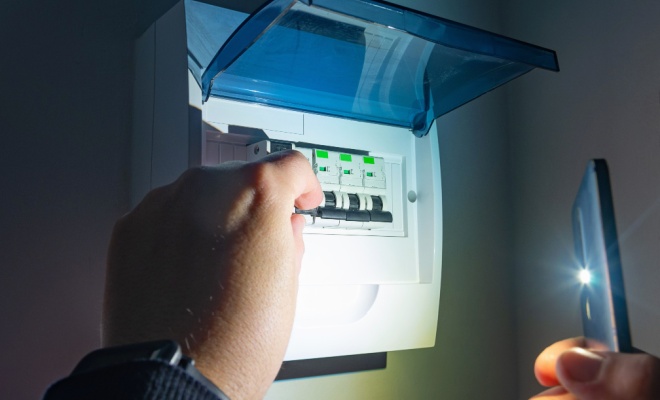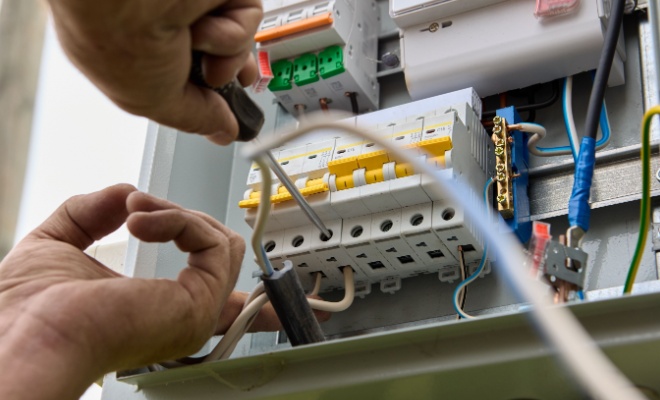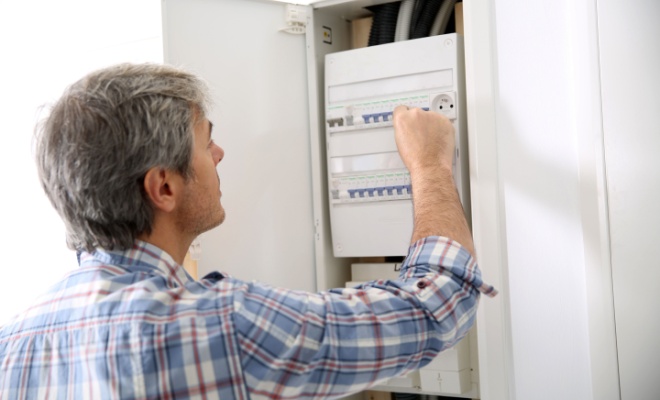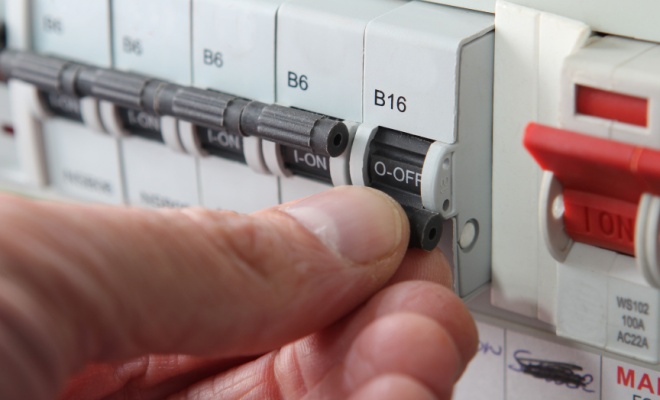Consumer Unit Replacement Cost
Last updated 12th September, 2025
Do you need to know the cost of replacing your fuse box or fitting an electric consumer unit?
If you've been thinking about renewing your old fuse box you've come to the right place. We discuss how much a fuse box replacement will cost, the types of electrical consumer unit available and the installation fees involved with this type of work. The cost to replace a fuse box is normally around £500 - £600 depending on the number of circuits required.
Keep reading for more!

How Much to Replace a Consumer Unit?
A new consumer unit/fusebox replacement will range from £500 to £600.
The above price includes the supply and installation costs of fitting a new consumer unit.
Does this include the cost of removing an old fuse box?
The fuse box removal cost is not included in this price. You may be charged an additional fee for the removal of the old fusebox, which ran range from £150 to £200.
The cost also covers any testing and paperwork that is performed to ensure the consumer unit is completely safe.
Prices may vary depending on the amp rating.
For example...
A smaller consumer unit with a 40-amp rating will only cost around £250 to £300, while a larger unit with a 100-amp rating could range from £470 to £510 or more.
Will I receive a consumer unit certificate?
Once your consumer unit is installed, the installer will provide you with a certificate to legally validate your new consumer unit. This will be included in the overall cost.
Table of Contents
- How much to replace a consumer unit?
- How much does a new consumer unit cost to buy?
- Additional consumer unit replacement costs
- Labour cost to replace a consumer unit
- Types of consumer unit
- Commercial consumer unit cost
- Upgrading your consumer unit
- What does replacing a consumer unit box involve?
- Difference between a fuse box and consumer unit
- Can I install a new fuse box myself?
- How much does a consumer unit cost to move?
- Consumer unit rules and regulations
- Do I need to notify anyone about moving my consumer unit?
- Cost of consumer unit maintenance and repairs
- Cost to remove a consumer unit
- FAQs
- How to find and hire an electrician to replace a consumer unit
- Sources
Consumer Unit Replacement Prices
Here are some estimated costs of hiring an electrician to install a new consumer unit:
| Number of Circuits | Avg. Cost | Duration |
|---|---|---|
| 6 | £500 | 3-4 hours |
| 10 | £550 | 4-5 hours |
| 12 | £600 | 5-6 hours |
The cost sometimes depends on the amp rating.
Here are some average prices for consumer units with different amp ratings:
| Amp Rating | Avg. Cost |
|---|---|
|
40 amp unit
(2 modules and 2-3 ways) |
£270 to £300 |
|
63 amp unit
(1-6 ways) |
£300 to £350 |
|
80 amp unit
(7-10 ways) |
£390 to £440 |
|
100 amp unit
(7-16 ways) |
£470 to £510 |
How Much Does a New Consumer Unit Cost to Buy?
If you would prefer to purchase a new consumer unit yourself, you need to consider the following supply costs:
| Number of Circuits | Avg. Cost |
|---|---|
| 6 | £150 |
| 10 | £180 |
| 12 | £200 |
Additional Consumer Unit Replacement Costs
When calculating the cost of your consumer unit installation, you may also want to consider the following costs:
| Description | Avg. Cost |
|---|---|
| Residual current device (RCD) | £20 to £60 |
| Isolators | £10 to £16 |
| Safety lock-offs | £5 to £15 |
| Surge Protection Device (SPD) | £40 to £120 |
| Miniature circuit breaker (MCB) | £2 to £30 |
| Residual Current Circuit Breaker With Overload (RCBO) | £20 to £40 |
| Earth Bonding | £150 to £250 |
Consumer Unit Cost Breakdown Calculator
Individual costs for replacing a fuse box with a new consumer unit with 10 MCBs - Total Cost: £450
Materials
£225
Tradesmen
£225
Waste Removal
£0
Labour Cost to Replace a Consumer Unit
Now, let's look at the labour costs associated with a replacement consumer unit and how long it takes to replace a fuse box.
Most electricians will charge around £40 to £80 per hour, although some have a daily rate of £150.
However, tradespeople will usually work in pairs, so you can expect to pay around £250 per day.
The actual consumer unit fitting should take around half a day to complete but may take up to a day if any faults are identified with testing.
Bear in mind that electrician prices will vary depending on where you are in the UK. Electricians in London and the South East will generally charge more for their services.
How Does An Electrician Quote for a Consumer Unit?
Your electrician will likely follow these steps in quoting for and installing your new consumer unit:
- Initial inspection of all electrical installations in your home (this may take 2 to 4 hours).
- Physical inspection and fault finding to establish what is working and what isn't.
- Report back to you and provide a quote for the new consumer unit, plus any other jobs that may be required.
- If you accept, they will schedule a date and time to replace the old fuse box and fit a new consumer unit.
Once the work has been completed, you can expect your electrician to perform tests to check everything is working correctly. After this, they will issue you with a building control notification certificate.
Types of Consumer Unit
There are several types of consumer units which vary in function and cost.
Here are some of the most popular consumer units:
Fully Loaded Consumer Unit Cost
A fully-loaded consumer unit comes equipped with a full set of miniature circuit breakers (MCBs) plus two RCDs which help to create around 10 to 15 usable ways.
This is one of the most affordable options costing around £60 to £120.
The only problem?
Despite its cost-effectiveness, a fully-loaded consumer unit does not provide accurate circuit separation, so is therefore not used very often.
Split Load Consumer Unit Cost
A split load consumer unit features a main switch and a residual-current device (RCD).
This type of fuse box can be identified by the position of the MCBs which should be located on the side of the RCD, while the Residual Current Circuit Breakers With Overload (RCBO) is usually beside the main switch.
The price for this type of unit ranges from £80 to £125.
Garage Consumer Unit Cost
A garage consumer unit is a much more compact consumer unit, which is typically used for exterior buildings such as garages, sheds and extensions which require a separate fuse box.
Do small spaces need a consumer unit?
In smaller spaces, a full unit is not necessary, so many opt for a garage consumer unit which has between 2 and 5 ways units.
As it is much smaller than typical consumer units, it only costs around £25 to £60.

RCD Dual-Split Consumer Unit Cost
An RCD dual-split consumer unit features two sets of circuits that are powered by individual RCDs.
For instance, the first RCD may be used to power all the electrical installations upstairs, while the other controls everything downstairs.
Having two different sets is beneficial, especially if the power is tripped on one circuit, homeowners can still rely on the other circuit.
The supply cost for this type of unit is around £40 to £130.
High Integrity Consumer Unit Cost
A high integrity consumer unit consists of three neutral bars which essentially offer three sets of circuits.
They are powered by RCBOs and two MCBs which provide complete circuit separation and protection for both standard and critical circuits. This is beneficial as it means any electrical faults on the fridge, for example, will not affect your lighting.
Despite its separation ability, it is actually one of the most inexpensive options costing around £50 to £150 for the unit itself.
Domestic Switch Fuse Consumer Unit Cost
A domestic switch fuse is a small consumer unit which typically only has one circuit that connects with system extensions or the sub-mains to create a secondary main switch.
The price for this small consumer unit is typically around £30 to £80.
Populated Consumer Unit Cost
Populated units come fitted with all devices, including the main switch, Dual RCDs, MCBs, and an isolator switch.
This saves time and money during the installation process as no extra parts are needed.
Populated units typically cost around £30 to £230.
Part-Populated Consumer Unit Cost
This consumer unit comes supplied with a main switch and RCDs, although it offers some flexibility for additional parts such as MCBs or RCBOs.
How much are part-populated consumer units?
The average cost of a part-popular consumer unit ranges from £25 to £140.
Unpopulated Consumer Unit Cost
Unpopulated models are a type of RCBO consumer unit which are supplied without any circuit protection.
This allows for configuration freedom.
You should expect to pay around £30 to £115 for an unpopulated consumer unit.
Commercial Consumer Unit Cost
Need a consumer unit for a larger space?
For larger properties or commercial spaces, a large distribution board will be required to accommodate more electrical appliances.
There are two main types of commercial distribution boards – single-phase neutral (SPN) and three-phase neutral (TPN) which usually have an amp rating between 100 to 125.
How do you know which consumer unit is right for your business?
To help you decide which consumer unit is right for your business, here is a breakdown of the different types of commercial consumer units and their costs.
Single-Phase Neutral Board Cost
A single-phase neutral board usually has two wires which control the flow of electricity. This is normally used for commercial premises with mostly lighting and heating.
Any downsides?
The problem with this type of commercial consumer unit is that the power can be inconsistent as the power reaches its peak at the same time through both wires.
These tend to cost around £70 to £85 for a 4 to 10-way consumer unit, while a 14 to 20-way unit is typically priced at £90 to £110.
Larger businesses may want to opt for a 28-way unit which can cost from £160 to £200.
Three-Phase Neutral Board Cost
A three-phase neutral board controls electricity through alternating currents with the same frequency and voltage. This allows constant power to be delivered evenly and effectively and at a much higher level than SPN boards.
What's the cost?
TPN boards are slightly more expensive at around £130 to £1,000 for a 4 to 8-way board. While a 12 to 18-way consumer unit tends to cost from £200 to £1,600.
Larger premises may opt for a 21-way unit which can actually cost up to £2,000 or more.

Upgrading Your Consumer Unit
Why do you need to upgrade a consumer unit?
Upgrading your consumer unit is extremely important because if you don’t upgrade, you could actually be risking your own life.
This is because a ‘healthy’ consumer unit with a residual current device (RCD) has the capacity to detect dangerous electrical threats as well as general ‘tripping’ issues.
If you do not have RCD protection, then you should consider upgrading your fuse box for your own safety.
You will also need to upgrade your fuse box if it does not meet the current UK wiring regulations which state that your consumer unit must protect against electrical overloading which can cause fires and electric shocks.
How much does it cost to upgrade a fuse box?
The cost of an upgrade will depend on your existing fuse box and the type of consumer unit you need.
For example, if you have a 40 amp unit that needs upgrading to a 63 amp consumer unit, this will cost around £300 to £350, while a larger upgrade to a 100 amp unit would cost around £470 to £510.
Keep in mind...
Before any work begins, the electrician will need to check the earth/bonding and also the power distributor's equipment where the metre is installed.
Any problems with this will mean the work being postponed until they are fixed and safe. Fault finding on the electrical system should also be carried out before the new unit is installed, that way the electrician will find out if any extra work may be needed.
What Does Replacing a Consumer Unit Box Involve?
While you should not try to undertake this job yourself, it's useful to understand how to replace a fuse box as it will allow you to understand what your electrician is doing and why.
Here's a breakdown of what the job entails:
- Before the installation begins, the main electrical power supply must be completely switched off.
- The fuse box will then be disconnected by taking the lid off the top unscrewing the fuses, unhooking the wires and removing the fuse box off the wall.
- Once the old consumer unit is out of the way, the new fuse box can then be attached. This involves removing the front panel of the fuse box and then screwing the back of the unit to the wall.
- When the unit is secure, the main wires will then be pushed back into place and connected to the right outlets.
- Any working circuit breakers from the original fuse box may be re-attached or replaced if new MCBs are required. Once these are in place, the front panel should then be screwed in and secured.
- Once everything is secure, your electrician will then perform an initial test using a voltmeter to ensure everything is working as it should. They may also perform additional circuit tests which will be recorded on an Electrical Installation Certificate, and a copy will be given to the homeowner. The Part P electrician will also log the work with the Local Building Control, and you should receive a letter from the relevant registered electrical body to confirm this.
Difference Between a Fuse Box and Consumer Unit
A fuse box and consumer unit are basically the same. It is just that a fuse box is now seen as a more outdated version of the consumer unit.
They both control the electricity that runs through your home while also monitoring the performance of electrical appliances.
They are responsible for the ‘tripping’ that occurs when any faults are flagged, which is conducted for your own protection.

The only real difference between the two is that older fuse boxes contain fuses with a wire inside which can melt in the event of an electrical overload. While a circuit breaker in more modern consumer units can switch off the unit automatically when an overloaded is detected and can then be reset on with no damage when the power returns.
Can I Install a New Fuse Box Myself?
No, you must not try to install a new consumer unit yourself.
A qualified electrician must do this job for it to be both safe and legal.
Aside from the dangerous aspect of a DIY consumer unit installation, there are other restrictions that can prevent you from conducting the task yourself.
This includes the regulations which require a qualified electrician to perform an Electrical Condition Installation Report before making any electrical changes like relocating your electric meter.
By doing this, the electrician can determine the condition of the fuse box as well as any other electrical issues in your home, which you may not have noticed.
After the complicated installation process, a Part P notification will also need to be obtained, and this is not possible if you try to change the fuse box yourself.
A certified electrician who is registered under the competent person scheme must do it for you. This means they must be approved by the NICEIC, ELECSA, NAPIT, Stroma or any other government-approved electrical organisation.
How Much Does a Consumer Unit Cost to Move?
Why would you need to move your consumer unit?
If you are renovating your home, then you may need to move your consumer unit, especially if you plan to turn your electric cupboard into a bathroom or store cupboard.
You may also want to move it, so you have better access to it, rather than having to go outside to the garage or the basement.
Here's the cost for moving a consumer unit:
The cost of relocating a consumer unit is around £250 to £500.
However, this may increase if you require an electrical installation condition report, as this normally costs around £100 to £300 depending on the size of your property.
What does moving a consumer unit entail?
Moving a consumer unit will involve the help of a certified electrician who will first inspect and test the condition of your fuse box to establish whether it is working properly. If it is, they will proceed by removing your fuse box from the wall.
To do this, they will take the lid off the top of the consumer unit to allow them to disconnect the circuit breakers. After this is complete, the wires can then be unhooked, and the consumer unit can be taken off the wall.
They will then move the unit to the desired area, making sure that it is between 130mm and 140mm above the floor level to prevent damp damage.
Consumer Unit Rules and Regulations
The current regulations that all new consumer unit installations must meet are set out in BS 7671 Wiring Regulations ("18th Edition"). These are the rules your electrician will be working to.
There are regular updates to consumer unit rules that professionals will be aware of. For instance, regulations were updated in 2016 to state that new plastic consumer units must not be fitted in domestic properties - new installs must be of non-combustible materials to reduce the risk of fire.
Ultimately, if your electrician is making a choice that you don't understand, the best thing to do is ask them about it and follow their guidance. The completed electrical work will have to be signed off officially at the end of the job.
Do I Need an EICR First?
Ahead of a new consumer unit being fitted, your electrician may wish to conduct an Electrical Installation Condition Report (EICR) to understand if your home's wiring is currently safe and can function correctly.
This is not mandatory before a new consumer unit is installed, but it can be good practice to ensure there are no surprises during the changeover, especially in older properties.
An EICR can also help you understand whether a new consumer unit is necessary and whether you should consider other electrical jobs as well such as a full home rewire.
For reference, the cost of rewiring a house can be anywhere between £1,500 and £6,000, so it can increase your overall costs significantly. That said, it could be cheaper to get all your electrical work done at the same time.
What if the Fuse Box Fails an Inspection?
If the fuse box fails the inspection and testing, it needs to be changed immediately.
An RCD is now compulsory for all new electrical work, but they can be very sensitive and trip whenever an appliance or light switch is used.
This is fairly common and is normally solved by separating the circuits into at least an upstairs ring and a downstairs ring, though this will obviously involve extra wiring and cost.
Using an experienced and competent electrician is crucial as they will be able to predict exactly how much extra work is involved.
The Part "P" Regulations are very strict, and certificates for both the electrical installation and compliance with the Part "P" Regulations must be issued after completion.
However, certificates are only given if the work is conducted by a qualified electrician who is registered under the competent person’s scheme and is part of either the NICEIC, ELECSA, NAPIT, Stroma or any other certified organisations.
Regulations for Landlords
If you’re a landlord, it is a legal requirement that each property you own has an Electrical Installation Certificate from a qualified electrician to ensure that all electrical devices are working as they should.
This offers protection to you as a landlord while also ensuring your property is safe for your tenants, while also avoiding fines and invalidated insurance.
You should try to have as many electrical checks as possible to avoid fire hazards or electrical shock incidents.
Do I Need to Notify Anyone About Moving My Consumer Unit?
Before moving your consumer unit, you need to get in touch with your electric supplier to inform them of the above, and they can then switch off your electricity temporarily.
If you’re planning to upgrade your consumer unit in any way, then this will be classified as notifiable work. Therefore, you will need to make sure that the work is completed by an electrician who is registered with a governing body.
After the installation, they should provide you with an electrical safety certificate which will confirm that the work is compliant with building regulations.
Cost of Consumer Unit Maintenance and Repairs
Here are some common consumer unit maintenance and repair jobs:
Replacing Broken Fuse
If you have a blown fuse, you should try to have it replaced immediately by a qualified electrician.
How much would you pay to replace a broken fuse?
This will cost around £80 to £100 and will involve the removal of the broken fuse, which should be replaced with the correct cartridge fuse which will be screwed in place and tested.
To save money, you could consider purchasing the fuse yourself, which typically costs around £1 to £3 for a pack of 10.

Cost to Replace Circuit Breaker Switch
In contrast to fuse boxes, modern consumer units are supplied with circuit breakers rather than fuses. While these are less inclined to break, an older consumer unit may require a replacement of one or more of their circuit breakers.
The supply cost for circuit breakers is around £3 to £30 each, so if you’re buying yourself, you will need to have a look around to see which circuit breaker is right for your unit.
Who can replace a circuit breaker switch?
If you’re unsure and have no experience dealing with consumer units, then you should hire a professional to supply and fit the right circuit breaker, which will cost around £45 to £50 for a qualified electrician to fit a new circuit breaker.
Cost of General Consumer Unit Maintenance
To ensure your electrical supply is working properly, you should book a maintenance check every 5 to 10 years to ensure there are no faults.
However, some companies do offer annual electric checks which may be beneficial.
This typically costs around £100 to £300 for an Electrical Installation Report.
Another popular maintenance check is PAT testing which involves checks on all electrical appliances and is normally priced at £1 to £2 per item.
Cost of a New Sub-Panel
Do you need a separate electricity supply?
If you require a separate electricity supply in your garage, shed or new extension, then you will need to have a subpanel installed.
This is a smaller electric panel that supplies electricity to specific areas in and around your home. This ensures that the electric supply reaches this area to power things like heating and lighting.
The cost to add a new sub-panel is around £300 to £700.
It can actually save you more money in the long run, as it means you do not have to run any wires underground, so it will be less expensive when you end up changing your main electrical panel.
Cost to Remove a Consumer Unit
Here are some reasons why you need to remove a consumer unit.
If you need a new consumer unit or fuse box, then you will need to have the existing one removed. This will involve removing the lid off the electrical system followed by the removal of the circuit breakers or fuses, followed by disconnecting the wires.
The wires will then need to be straightened out to remove them and feed them through the entry holes.
After removing the wires, your electrician may re-organise the wiring in preparation for the new consumer unit.
Do you have any rubber wiring?
If there is any rubber wiring, this will need to be removed as it is no longer compliant with electrical regulations.
A qualified electrician will charge around £150 to £200, with removal usually taking around 1 to 2 hours.
FAQs
A fixed RCD provides the highest level of protection as it protects all the wiring and sockets and any connected appliances on a circuit. Not to be confused with portable or socket RCDs, which are portable devices which are plugged into wall sockets/appliances.
You should also try to choose a consumer unit from an established manufacturer that has a significant amount of space as this enables easy installation and repairs. You will also need to check how many circuits the unit can accommodate as well as the amp rating, as the more electrical appliances you have, the more modules you will need.
How to Find and Hire an Electrician to Replace a Consumer Unit
To ensure that your consumer unit is fitted correctly and is compliant with electrical regulations, you will need to hire a qualified electrician who is registered under the competent person scheme and member of NICEIC, ELECSA, NAPIT, Stroma or any other government-approved electrical organisation.
They will usually charge around £40 to £80 per hour or a daily rate of £150 to £250.
You should also inquire about their qualifications and experience which should include a Level 3 NVQ Diploma in electrical maintenance with around 5 years’ of on-the-job practice.
Try to avoid hiring anyone without public liability insurance, especially with an electrical installation, as this can be detrimental to both you and the tradesperson.
Sources
https://www.electrical-experts.co.uk/blog/when-should-consumer-unit-be-upgraded
https://www.mdbespokesolutions.com/blog/why-cant-i-change-a-fuse-board-or-consumer-unit-myself/
https://www.jifelectrical.co.uk/cost-replacing-fuse-boxconsumer-unit/










